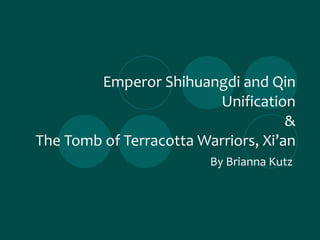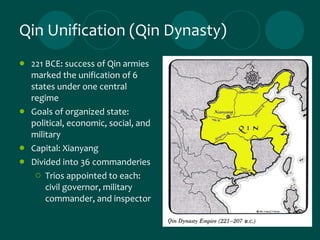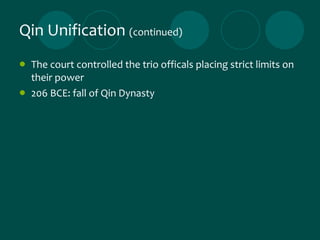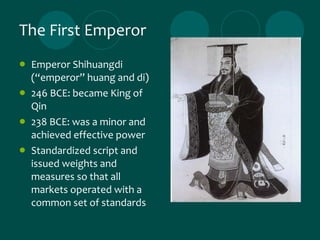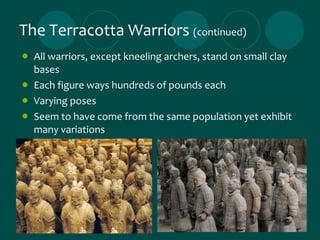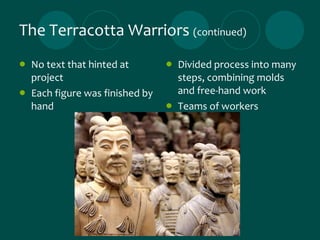Emperor shihuangdi and qin unification
- 1. Emperor Shihuangdi and Qin Unification & The Tomb of Terracotta Warriors, Xi’an By Brianna Kutz
- 2. Qin Unification (Qin Dynasty) 221 BCE: success of Qin armies marked the unification of 6 states under one central regime Goals of organized state: political, economic, social, and military Capital: Xianyang Divided into 36 commanderies Trios appointed to each: civil governor, military commander, and inspector
- 3. Qin Unification (continued) The court controlled the trio officals placing strict limits on their power 206 BCE: fall of Qin Dynasty
- 4. The First Emperor Emperor Shihuangdi (“emperor” huang and di) 246 BCE: became King of Qin 238 BCE: was a minor and achieved effective power Standardized script and issued weights and measures so that all markets operated with a common set of standards
- 5. The First Emperor (continued) Han writers denounce the First Emperor and his ministers for their harsh policies and immoral acts Seen as villian Ordered the destruction of defensive “long walls” and city walls. He kept an army in the field along the northern frontier and used it and other laborers to construct large-scale public works (The Great Wall)
- 6. The Tomb of the First Emperor Called Lishan and located in Xi’an 210 BCE: death of emperor 221 BCE: most active phase of construction directed by his chancellors, Lu Buwei and Li Si Unknown exactly when army was created but possibly throughout the most active phase
- 7. The Terracotta Warriors Terracotta: “baked earth”; clay-based unglazed ceramic 1974 BE: Farmers discovered when digging a well 750 ft long by 200 ft wide Separated in 11 corridors
- 8. The Terracotta Warriors (continued) 3 trenches Trench 1: 9 main corridors with life-size warriors, four abreast, facing east; 2 narrow side corridors have files of 2 warriors each, the outside file facing away from the main body of the army Large open area at the east end was accessible by 5 ramps 200+ warriors in 3 long ranks Trench 2: east end and was mainly filled with cavalry and archers Trench 3: west end and was kind of a headquarters Total number of warriors in all 3 trenches is estimated 7,000+ figures
- 9. The Terracotta Warriors (continued) 3 1 2
- 10. The Terracotta Warriors (continued) All warriors, except kneeling archers, stand on small clay bases Each figure ways hundreds of pounds each Varying poses Seem to have come from the same population yet exhibit many variations
- 11. The Terracotta Warriors (continued) No text that hinted at project Each figure was finished by hand Divided process into many steps, combining molds and free-hand work Teams of workers
- 12. Reference Thorp, R.L. & Vinograd, R.E. (2001) Â Chinese art and culture , 27-53, New York, NY: Harry N. Abrams, Inc.
Editor's Notes
- #3: Qin Dynasty was followed by the Han Dynasty Qin victory took several decades of intense warfare against strong states of the late Zhou period The emperor, his court, and bureaucracy could control and direct all aspects of society
- #4: The court required the local population to pay taxes and provide labor service
- #5: Had an estimated 28 children (4 names are known; the others are unknown possibly because they were from concubines) Wiki
- #6: Example of immoral acts: burning of the [the classics] books and killing of [Confucian] scholars Used up to recent decades as negative example addressing government policies and problems Han poet wrote Ten Crimes of Qin Created defensive lines, roads and canals Quote from The Myth of the Great Wall : “After Qin had unified the world, [General] Meng Tian was sent to command a host of 300,000 to drive out the Rong and Di along the north. He took from them the territory to the south of the Yellow River, and built a long wall.” (Waldron, The Great Wall of China , p. 17, modified)
- #7: Image: Shi Huangdi’s tomb; Pyramid? Many other computer generated ideas of what it actually looked like Included in tomb and chamber: sky map on the ceiling?, topographical map on the floor?, 2 chariots in bronze with 2 drivers and 4 horses/chariot
- #9: 4 trenches with Trench 4 no yet excavated Trenches 1 and 2 are the attacking troops with different function that obey Trench 3’s order as their headquarter
- #11: Horses stand on their thin, stiff legs without additional support Variations: facial hair and hair ( moustaches, chin whiskers, topknots, and plaited hair) Example: high-ranking officers wear special caps, a scarf tied at the neck, and tassels on their chest armor Example: others wear different headgear and armor. Others not armored.

